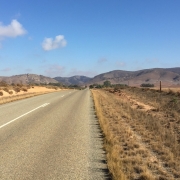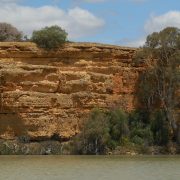The River Murray Weirs – Part 3 of 3: Mitigating the Impacts
The River Murray Weirs were constructed 100 years ago to provide passage for riverboats and to supply water to inland communities. But the weirs have also degraded wetlands, salinised floodplains and devastated native fish populations.
In this final article I describe how weirs are now being managed to reduce their impacts and even to help the environment.
Mitigating the Impacts
Over the course of the 20th century River Murray flow was gradually brought under tighter control. Weirs, dams and control systems were used to reduce flow variability and to provide reliable water supply.
Until the 1990s the main purpose of these investments was economic prosperity. But, starting with the weirs, environmental outcomes have gradually been introduced to river operations and environmental health is now central to how the river is run.
1. Fishways
The harm caused by weirs to migrating fish was obvious as soon as they were constructed.
Fish swimming upstream were blocked at the foot of each weir. In 1928, so many fish accumulated below the new Torrumbarry weir that the river was being plundered by commercial and recreational fishers. Fishing was banned for a mile downstream to give the fish a chance. Similar impacts were observed at other the weirs. The weirs represented such a threat to inland fisheries that there was an outcry among fishers and conservationists.
To overcome the problem, fishways were proposed. A fishway is a flowing channel that provides a long, gentle slope for fish to swim around a weir. Fishways had proved effective for salmon in North American rivers, so similar designs were used to build fishways at Lock 6 and Lock 15 in 1930 and 1937.
Unfortunately neither fishway worked well. The designs that suited energetic salmon in fast-flowing snow-melt streams did not suit Australian fish species in the River Murray.
In any case, building fishways in only two of the thirteen weirs was never going to do much good. Due to cost, a lack of ecological expertise and poor cooperation between the states, plans for further fishways were shelved.
It was not until 1990 that an effective fishway, designed specifically for Australian fish, was built into Torrumbarry Weir. This encouraged the installation fishways in all the weirs and the barrages under the Hume to Sea program which has reconnected over 2,200 km of the River Murray from Albury to the Murray Mouth.
2. Floodplain Inundation
The river channel is only a small part of the River Murray ecosystem. By far the biggest component is the floodplain it flows through.
Floodplain inundation at Paringa, South Australia (M. Cooling)
The floodplain includes the forests and wetlands that are inundated when the river breaks its banks. The River Murray floodplain covers hundreds of thousands of hectares and reaches up to 10 km across.
Before the river was developed, the floodplain was inundated almost every year. Flooding has now been reduced by reservoirs that capture high flows. Extractions have also reduced floods by pumping water from the river into farm dams and crops.
The floodplain is now in a state of on-going water stress. Trees are in poor health, vegetation is sparse, wetlands and lakes are frequently dry and frogs and birds have fewer opportunities to breed.
At some key localities, weirs are being used to restore floodplain inundation. Diverting water from the weir pool to the floodplain can replicate a flood event even when river flows are low.
This was first achieved at Lock 8 where water is diverted on to Mulcra Island. Similar schemes have been developed at Torrumbarry Weir and Chowilla and are being planned at Lock 7, Lock 5 and Lock 4.
Weirs are being used to divert water from the river to inundate the floodplain.
3. Water Level Variation
The weirs have been incredibly effective in stabilising river levels. Careful management of the weir enables operators to keep the upstream level steady, even when river flows change.
The weirs are operated to keep upstream levels stable. Downstream levels fluctuate according to flow (MDBA Data).
Stable river levels are harmful to river ecosystem. Wetlands and forests need to be flooded by high water levels in spring. Grasslands and meadows grow on the banks exposed by low levels in summer.
Weirs are now used to provide seasonal cycles in water level. The first seasonal pattern was created in 2012 when Locks 8 and 9 were raised in winter and lowered in summer.
Seasonal weir cycles are now being introduced to all of weirs downstream of Euston.
Lowering the weir during spring allows aquatic plants to colonise the river edge upstream of Lock 8 (Scott Jaensch)
4. Fast Flowing Water
Slow-flowing water has been one of the worst impacts of the weirs.
Weirs make the river deeper and wider. They slow the flow of water to a crawl. Fast-flowing habitat has been virtually eliminated along the continuous chain of weirs from Mildura to the Murray Mouth. Species that depend on fast-flowing water, such as Murray Crayfish and Trout Cod, have gone extinct in the Lower Murray.
There are two locations where fast-flowing water persists in the Lower Murray, and both are floodplain channels that by-pass the weirs. Mullaroo Creek flows around Lock 7 and Chowilla Creek flows around Lock 6. Both support healthy populations of native fish that are absent elsewhere in the region.
There are proposals to create similar conditions by diverting water from weirs into the creeks that flow around Lock 8 and Lock 4.
There are also proposals to restore fast-flowing water in the river channel. If weirs are lowered far enough, fast-flowing conditions can be restored upstream.
There are few places where weirs can be lowered to this extent. Nearly every weir pool has a dense array of irrigation pumps and diversion channels that would be stranded by low water levels. At this stage, Lock 8 is the best candidate.
Opening the weirs lowers the river level and creates the higher velocities on which native fish and crayfish depend.
Conclusion
These are four important ways that weirs are used to improve the environment.
But they do not make up for the damage the weirs do.
Even with fishways, the weirs will never be entirely transparent to fish. Inundating localised floodplains is a poor substitute for natural, widespread flood events. And restoring a few kilometres of fast-flowing habitat is only a token of the former free-flowing 900 km Lower Murray.
The environmental achievements in weir operations are important. But our benchmark should be ‘river health’ and we still have a lot of work to achieve it.
Sources and Further Reading
Barrett, J. and Mallen-Cooper, M. (2006). The Murray River’s ‘Sea to Hume Dam’ fish passage program: progress to date and lessons learned. Ecological Management and Restoration 7: 173-183.
Ecological Associates (2015). Environmental Water Management Plan for the Murray River from Lock 6 to Lock 10 – System Characterisation. Ecological Associates report AL043-1-A prepared for Mallee Catchment Management Authority, Irymple.
Government of South Australia (2012). Weir Pool Manipulation
Lawrence, B.W. (2014). A history of fishway policy on the River Murray – 1928 to 1988. Unpublished article circulated by finterest.com.au
Acknowledgements
This series of articles is based on work I have done for the New South Wales Office of Water, South Australian Department of Environment, Water and Natural Resources, North Central Catchment Management Authority and the Mallee Catchment Management Authority.
Thanks to Lance Lloyd for comments on the text.









